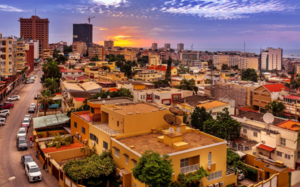Mambiza
Mambiza | |
|---|---|
City and Province | |
 A sunset view of Mambiza, overlooking the Chipungowe district and its beach | |
| Nicknames: Iron City | |
| Motto(s): "Guta relron" ("The city of iron") | |
| Coordinates: 8º41'N 33º39'W | |
| Country | Garambura |
| Province | Mambiza |
| Founded | 1656 |
| Incorporated (city) | 1841 |
| Renamed | 1970 |
| Government | |
| • Governor | Rupenyu Majange |
| Area | |
| • City and Province | 1,253.9 km2 (484.1 sq mi) |
| Elevation | 13 m (43 ft) |
| Population (2014) | |
| • City and Province | 3,873,288 |
| • Density | 3,089/km2 (8,001/sq mi) |
| • Urban | 3,762,000 |
| Demonym | Mambizan |
| Time zone | UTC+4 (Eastern Bahian Time) |
| Area code | 85 |
| Climate | Cwb |
| Website | cityofmambiza |
| Dialling code 85 (085 in Garambura) | |
Mambiza (/'mæmbi:za/; officially Saint-Germain until 1970) is the largest city in Garambura. The city has one of the largest designated metropolitan areas in Garambura, at 1,253.9km2 (481.4mi2), and an urban population of 3,762,000 in 2014, with a total population of just under 3.9 million inhabitants. Mambiza itself is a metropolitan province of Garambura, and is represented by its elected governor Rupenyu Majange. The city sits on the expansive Gonda Delta and its coastal location makes it a popular destination for global trade.
The city was founded as a trading outpost in 1656 by Gaullican merchants, who named the city Saint-Germain after the Sotirian venerated figure. It served as a stopover for trade between Euclea and southern Coius, namely Xiaodong and Senria, and so the city's wealth grew under the Gaullicans. It was designated as the capital of the Terre-Noire colony when it fell under full Gaullican sovereignty in 1840, and was designated a city in 1841. Mambiza was the site of Charles Moreau's famous Droits de l'homme speech in 1919, before he was executed in the city by national functionalists. Many of the city's inhabitants were conscripted during the Great War. The capital was moved and the city renamed to Mambiza in 1970 after Garambura secured its independence.
History
Merchant city (1656–1813)
The location that the city of Sainte-Germaine would be settled on would be granted as a charter to the newly-created Gaullican Lower Gonda Company, founded in 1655 to subsidise colonial ventures in the region, by the Crown of Gaullica. The Gaullians settled the delta of the Gonda river sometime around October to November if 1656, with native contact being made shortly after. Early evidence suggests that the Gaullicans exhibited a native co-existence policy for the city, and thus the city had some natives as an early populace. This early contact between the natives and Gaullicans is estimated to be the likely emergence of the Palatara creole, now spoken in the city.
Due to this city's location in a natural bay and on extremely fertile and arable land, it grew quickly and established itself as one of Gaullica's primary ports for the transportation of Bahian slaves to the Asterias at the height of the Asterian Slave Trade. The city's predominantly white populace combined with the policies of Toubacterie exhibited within the city led to many of the city's Euclean residents becoming wealthy property and land-owners, with some choosing to employ natives as labourers and others choosing to expand the city's infrastructure with their plot of land, with many residential areas, including early hotels and inns, being constructed during this period.
When slavery was abolished throughout the Gaullican Empire, the city's connections throughout the empire, particularly those back to Euclea and to Gaullican holdings in the Asterias, allowed it to stay as a financial hub in Bahia and retain its wealth while many other settled ports by Euclean nations dwindled as their main exports were severely neutered. The city also prospered due to its large fishing industry, an industry which many native residents of the city were employed in. As such, Sainte-Germaine became known for its exotic fish markets in the 18th century, with the exports of fish and the tourism into the city contributing to a significant chunk of its economy. This was only amplified when the Gaullican Lower Gonda Company began expanding its holdings inland and across the Garamburan coast, with Sainte-Germaine functioning as the de facto capital due to its history as the influential city on the Garamburan coast. The city's economy did take a brief hit, however, during the Plundering of Sainte-Germaine, where Karame Mabuti I and his forces raided and plundered the city for encroaching upon native territory in the central portions of Garambura. Its economy swiftly recovered after the 1774 Battle of Ingezi which marked the effective dominance for Gaullica throughout most of the Gonda river region.
